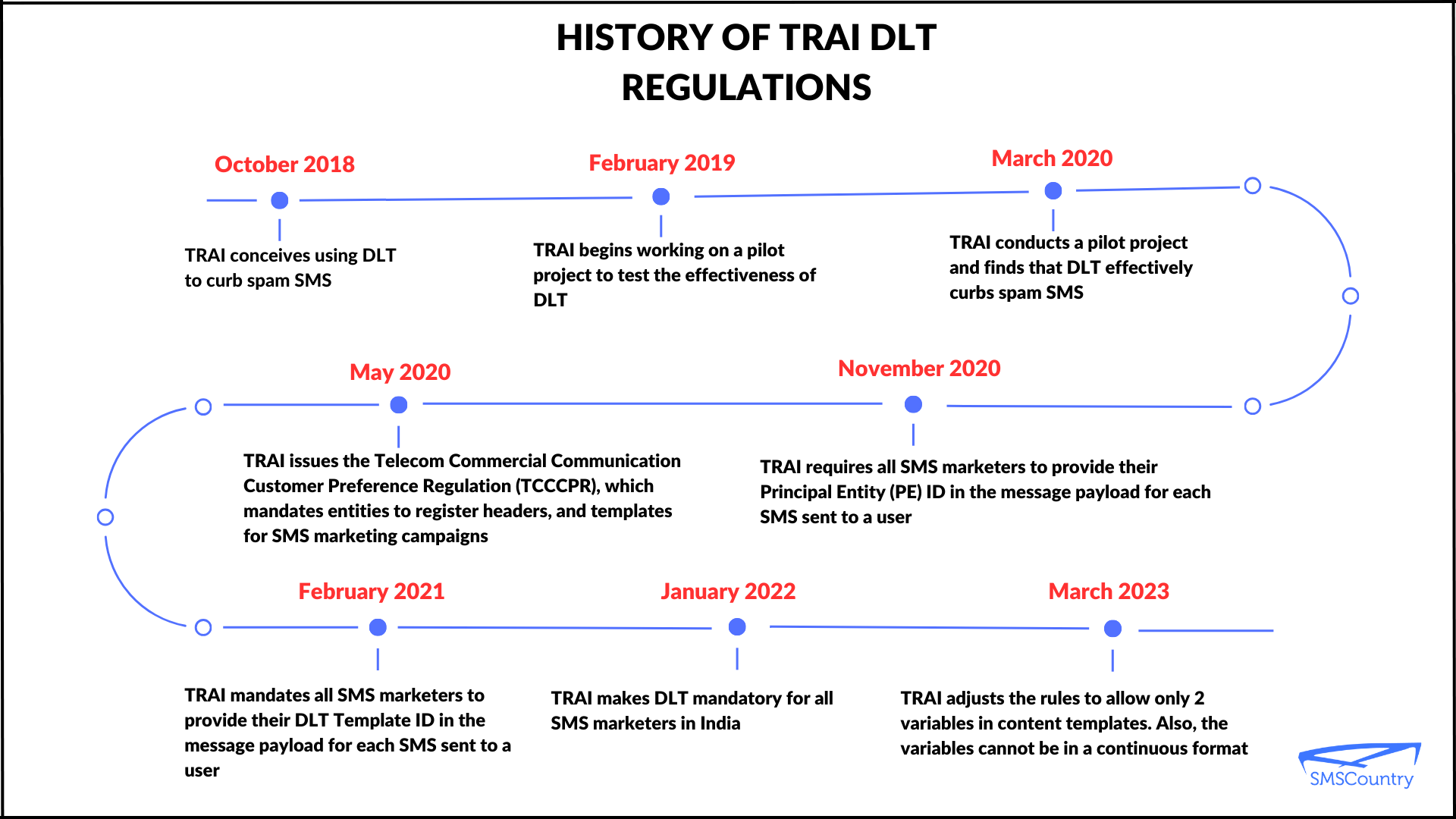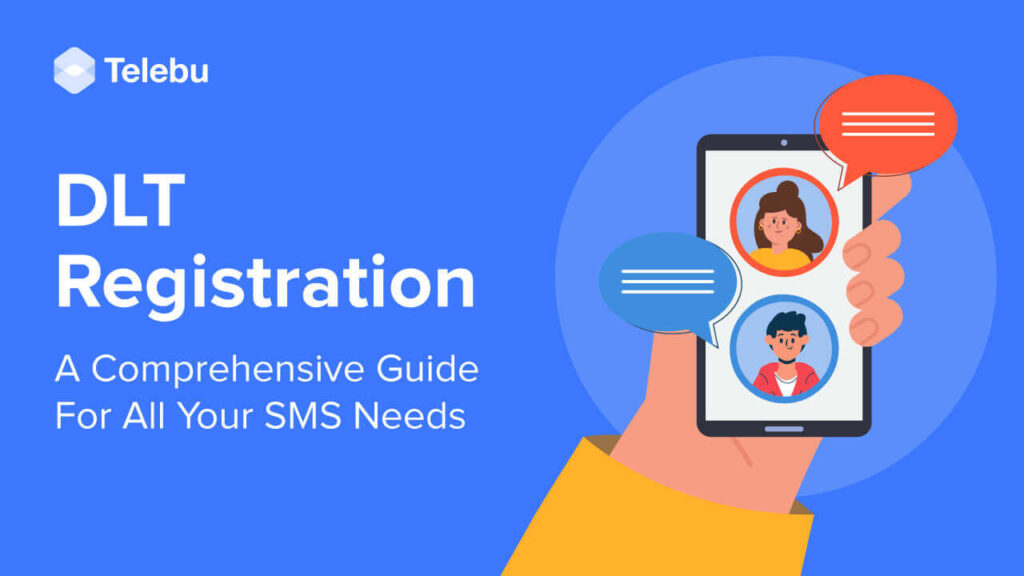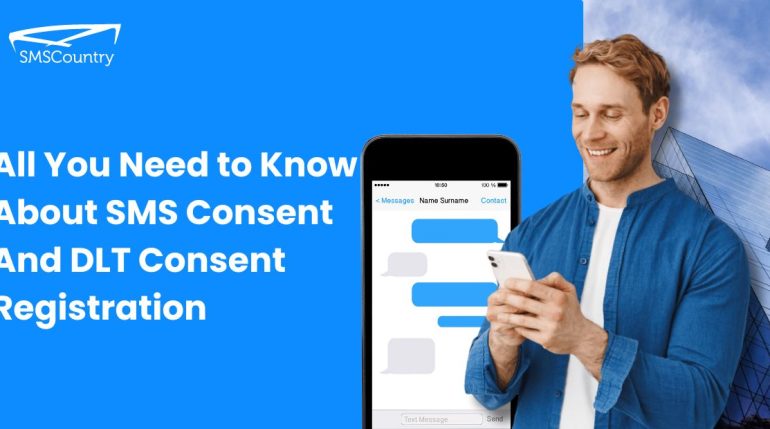Do you want to send SMS to your customers in India, but the DLT registration process seems confusing?
The sad reality is that without understanding DLT and successfully registering your business on DLT, you can’t enjoy all the awesome benefits of SMS.
Even sadder is that because DLT is new, some grey areas may exist that can negatively affect your business.
Don’t worry. We’ve got you covered.
At the end of this article, you’d know exactly what DLT is and how to go about the DLT registration process.
Let’s dive in!
Note: because of the technical nature of DLT, we used some “big words” in this article. But we tried to explain what they mean where possible.
| Want our DLT experts to hold your hands and help you through the DLT registration process? Contact us now! |
Learn more about DLT:
- 4 expert tips for a successful DLT registration
- 5 Reasons for DLT Registration Rejection and How To Avoid Them
- 4 Top Reasons Your DLT Template Registration will be Rejected
- 5 Expert Tips For Successful DLT Template Registration
What does DLT stand for?
DLT means “Distributed Ledger Technology”. It is a digital system of keeping a record and managing sender IDs and templates.
There is another term you should know. It is called TRAI, which is short for “Telecom Regulatory Authority of India”.
But how do these two concepts relate?
TRAI introduced DLT to regulate the bulk SMS industry in India.
Based on the TRAI guidelines, you cannot send bulk SMS or voice messages in India without a DLT registration.
The aim? To protect your customers from SMS spam and fraudulent activities.
But on the other hand, what do these new laws mean for you and your business?
Under these laws, you must follow certain guidelines and steps before you send SMS to your customers.
What is the meaning of DLT registration?
DLT registration is the process of registering your business, sender IDs, message templates, and other required information on a Distributed Ledger Technology (DLT) platform.
It is a mandatory step in many countries which ensures your SMS marketing efforts comply with telecom regulations.
TRAI has mandated that all businesses sending SMS messages in India register with a DLT platform. This is to protect the privacy of consumers and to make it more difficult for spammers to send unsolicited SMS messages.
To register with a DLT platform, your business must provide certain information, including business name, address, contact information, and the purpose of your SMS campaigns. Once registered, your business will be given a unique identifier to use when sending SMS messages.
Consumers can also use DLT registration to opt out of receiving SMS messages from businesses. To do this, they can text “STOP” to the SMS message they receive from the business.
DLT registration is a simple and effective way to protect consumers’ privacy and reduce spam SMS in India.
What led to the implementation of these laws in India?
History of DLT
According to a report from TRAI, in India, there are:
- 1.2 billion total mobile subscribers
- 230 million subscribers registered in DND
- 30 billion total messages sent in a month
- 22,000 registered telemarketers (before DLT)
- 10+ lakhs SMS senders
- 10+ lakhs SMS headers
- 1.2 million SMS disconnections due to illegal telemarketing activities
Now this will interest you. 85-90% of the total SMS senders in India are spammers/fraudsters.
This high percentage of spammers led to a lot of problems.
Here are a few of them:
- Increase in fraudulent activities: Illegal activities have increased over the years. This caused trouble for businesses that use SMS to communicate with their customers.
- Inability to track SMS senders: Communication regulators in India couldn’t trace SMS senders and third-party vendors. They didn’t have enough information to do that.
- Difficulty in penalising scammers: It took over seven days to arrest a fraud or a scammer.
The lack of regulations exposed customers to privacy infringement, fraud, and data loss.
That is why TRAI introduced DLT to solve this problem and properly regulate the use of SMS in India.
DLT implementation brought regulation and fair play to the use of SMS. It also put to an end the problems that businesses and customers faced due to spam messages.
Here’s the history of TRAI DLT regulations till date.

We also presented it in a table, as shown below.
| Date | Event |
| October 2018 | TRAI conceives using DLT to curb spam SMS |
| February 2019 | TRAI begins working on a pilot project to test the effectiveness of DLT |
| March 2020 | TRAI conducts a pilot project and finds that DLT effectively curbs spam SMS |
| May 2020 | TRAI issues the Telecom Commercial Communication Customer Preference Regulation (TCCCPR), which mandates entities to register headers, and templates for SMS marketing campaigns. |
| November 2020 | TRAI requires all SMS marketers to provide their Principal Entity (PE) ID in the message payload for each SMS sent to a user |
| February 2021 | TRAI mandates all SMS marketers to provide their DLT Template ID in the message payload for each SMS sent to a user |
| January 2022 | TRAI makes DLT mandatory for all SMS marketers in India |
| March 2023 | TRAI adjusts the rules to allow only 2 variables in content templates. Also, the variables cannot be in a continuous format |
Now that you understand the history of DLT, let’s jump into how DLT works.
How does DLT work?
Think of DLT as a digital ledger that records transactions and their details across a network in multiple locations.
As it is based on distributed tech, DLTs have no central control or database. But they can store a lot of information and data.
It can also eliminate any unauthorised data changes.
It does this by matching the information with the changes required. The change occurs only when the business, telecom provider and TRAI reach a consensus.
How does DLT work in telecom?
In the telecom sector, DLT regulates and manages the flow of SMS and voice SMS.
It reduces spam and fraud by permitting only authorized businesses to conduct business via SMS. The DLT ledger is a transparent system where telecom operators and businesses register and validate their sender IDs, templates, and content.
What is the purpose of DLT (Why DLT)?
The purpose of DLT is to regulate and manage the flow of communications, such as SMS and voice calls. DLT aims to minimise spam, fraudulent activities, and unsolicited messages.
It creates a transparent and decentralized system where telecom operators, businesses, and regulatory authorities collaborate to create a trustworthy experience.
Vahini Joseph, from our customer support team, throws more light on the benefits of DLT in this short video.
The goal of DLT is ‘safe and secure data’.
That means when needed, data gets replicated with 100% accuracy in a secure way.
And there is more.
Digital keys and signatures secure the DLT-maintained data. Only the person with the digital key can access the record.
What does DLT registration mean to your customer?
- Your customers get more control over their consent and their preferences.
- The choices, consents, and preferences of your customers get reflected in seconds in DLT because of blockchain technology.
- Your customers get heard. They get the right to a quick and easy complaint resolution.
- Your customers get enhanced security and privacy for their data.
What does DLT mean to bulk SMS service providers?
- DLT reduces your risk of fraudulent activity because of the many regulatory compliances you must follow.
- DLT reduced the upfront cost of starting a telemarketing business.
What does DLT mean to you as a business owner?
- DLT enables you, as a business owner, to target and reach your audience according to their interests and preferences.
- Your client data is stored safely and securely, even when shared with other entities.
- Your SMSes get a verification badge after authentication and verification via DLT. This gives your business an identity and increases brand awareness.
Many rules and regulations ensure the implementation of DLT. And if you do not comply, your business cannot send or process SMS in India.
The next section helps you understand some of the terms we’ve used so far and some we’re still going to use.
| Want our DLT experts to hold your hands and help you through the DLT registration process? Contact us now! |
DLT glossary and terms
To follow the rules and regulations of DLT, you need to understand some terms. Here are five of the must-know DLT terms.
- Principal entity: This is an individual, firm, government agency or business trying to send SMS to their customers. A principal entity is an organisation that sends SMS to end consumers. As per the TRAI rules, every entity must register with the telecom operators in the DLT platform.
- End customer: This is the mobile subscriber who will receive your SMS. The end customer needs to consent to receive promotional SMS from any business. Also, end customers can set their preferences, register complaints, and even unsubscribe anytime.
- Service provider: These are the bulk SMS providers. They are telemarketers. They are the ones who enable businesses and companies (like you) to send bulk SMS to their audience. Every service provider must register on the DLT platform to send messages on behalf of the principal entity.
- Telecom operators: Telecom operators are also known as access providers. They are directly connected to TRAI and help in the regulation process. Some popular telecom operators in India include Vodafone, Airtel, Idea, and BSNL.
- Regulator: The regulator establishes the regulatory compliance needed for commercial communication’s smooth and efficient functioning. In India, TRAI is the regulator. TRAI audits the operations to protect the customers and prevent fraudulent activities.
Now let’s move to how to register on DLT.
How to register on DLT: DLT registration process
The entire DLT registration process comprises three phases.
- Entity registration
- Sender ID registration
- Template registration
Followed in order.
Let’s walk through each of them one after the other
Phase 1: DLT entity registration
Your first step is registering your business (the principal entity) with a verified operator.
To complete this successfully, you need the following documents:
- Business PAN
- GST certificate
- Company registration certificate or any other valid identity or address proof
Phase 2: Sender ID registration
After entity registration, your next step is registering your sender ID on DLT.
You will need to create a sender ID for your SMS campaigns. Without a sender ID, you cannot start sending SMS.
Phase 3: Template registration
You made it to the third phase.
This is the most important phase in the registration process.
Here, the operator will approve or reject your SMS template. You cannot send SMS that is not DLT-approved.
We created a DLT template registration guide to guide you through the template registration process.
| Want our DLT experts to hold your hands and help you through the DLT registration process? Contact us now! |
Step-by-step guide for DLT registration
To help you complete your DLT for any telecom operator in India, we’ve created individual step-by-step DLT registration guides.
Each guide contains screenshots of the process that will walk you through the three stages of DLT registration for that telecom operator.
Visit the one for your telecom operator:
- Airtel DLT Registration Process – How To Get Approved on First Attempt
- BSNL DLT Registration Process: The Ultimate Step-by-Step Guide
- Vodafone DLT Registration Process – How Do You Get Approved on Your First Try?
- Jio DLT Registration Process: Follow This Step-By-Step Guide to Get Approved on First Try
Sometimes, your DLT registration may not be approved on the first try due to some mistakes, most times from your end. We discussed some of these mistakes in 5 Reasons for DLT Registration Rejection and How to Avoid Them
To help you ensure your first DLT registration is successful, we contacted DLT experts and asked them how to ensure your first DLT registration is successful.
See the four expert DLT tips they shared to help ensure your DLT registration is approved on your first try.
Looking for a reliable bulk SMS service provider? Or is your current SMS service provider making you look bad before your customers?
With SMSCountry SMS API, plugins and app, your voice, OTP, transactional and promotional SMS gets delivered in less than 3 seconds.
What are the DLT registration sites?
There are quite a few DLT registration sites. Identifying and choosing the best one from the long list can get difficult for you.
Let’s make things easier. Here are the top 6 recommendations of the leading operators:
Some operators, such as Airtel, offer offline DLT registration as well.
Have more questions about DLT?
Check out our page for frequently asked questions about DLT.
You’d be sure to find your answers there.
If you have more questions. Contact us asap!
What are the charges for DLT registration?
The entity/enterprise/telemarketer aggregator function costs 5000 INR + 900 INR GST. While the telemarketer delivery function charges are 50,000 INR + 900 INR GST.
Before you register on any particular site, check if it is free or paid registration.
SMSCountry telemarketer registration ID
You may be wondering what a telemarketer registration ID is. A telemarketer registration ID is a unique identification number assigned to telemarketers by (TRAI). It helps to regulate unsolicited commercial communication.
While registering with a DLT platform, you’ll need to add a telemarketer ID. You can enter the ID of your telemarketer. If you don’t have one, then choose SMSCountry as your preferred telemarketing service provider.
No matter which DLT portal you’re registering on, simply select SMSCountry from the list or/and enter 140200000033. That’s SMSCountry’s ID.
SMS regulations before and after DLT
| Before DLT | After DLT | |
| DLT scrubbing | Only check for DND numbers | Messages are blocked if parameters are missing |
| Header registration | N/A | Mandatory to register a header before the actual SMS |
| Telemarketer registration | N/A | As of May 1, 2023 TRAI will use AI to detect unwanted SMS. If there is no telemarketer registration, such entities will be blacklisted |
| Message types | Two routes: Promotional and transactional | Four types of messages: Promotional, Service Implicit, Service Explicit and Transactional SMS |
| Customer preference customization | Can be added. Not mandatory. | Preferred for a better campaign outcome |
| Customer consent | Not required | Mandatory when sending promotional SMS |
| Complaint management | N/A | TRAI established a system for complaint redressal with the service providers. |
| Telecom service provider interoperability | N/A | DLT platform enables transparent information sharing between service providers |
| Traceability | N/A | Enabled tracing SMS, subscribers and businesses |
| Onboarding process | Customers submitted their preferred Sender ID with no check for uniqueness. | Both entities and telemarketers need to register with the DLT platform for unique IDs. |
| Message timing | Without any check, messages breezed through the system | With DLT messages need verification to be sent to the recipient requiring some extra time |
| Opt-in | Not required | Required for promotional SMS.Consent is required for transactional SMS. |
| Opt-out | Not required | Required for promotional SMS |
Register yourself for success
There you go – the complete DLT registration process. Now you can start building brand trust and loyalty with your customers.
Want our DLT experts to hold your hands and help you through the DLT registration process? Contact us now!
FAQs about DLT and DLT registration
We answered some of the frequently asked questions about DLT and DLT registration in India.
If you don’t find answers to your questions here, check out our main DLT FAQ page for a comprehensive list of all the the questions and answers there is about DLT.
Find the link to the DLT FAQ page at the bottom of this list of FAQs.
What is the full form of DLT?
DLT stands for Distributed Ledger Technology.
How much does DLT cost?
DLT registration costs vary from service provider to service provider. It’s best to reach out to different DLT providers to get accurate pricing information.
What is required for DLT?
To get started with DLT registration, you’ll typically need the following:
- Your business registration documents
- Proof of identity
- Details of authorised signatories
- Sender IDs
- Templates you plan to use for SMS.
Also, ensure you are working with a registered telecom operator or SMS service provider to comply with the regulations.
What is an example of a DLT?
A very common example of a distributed ledger in action is cryptocurrencies like Bitcoin. Cryptocurrencies employ blockchain, which is a form of distributed ledger.
What are the types of DLT?
There are several types and designs of DLT, each with its characteristics. The most popular is blockchain. Others include Hashgraphs, DAG (Directed Acyclic Graph), Holochain and Tempo (Radix).
Is DLT a Blockchain?
DLT (Distributed Ledger Technology) is a broader term encompassing various technologies and systems, including blockchain. Blockchain is a specific implementation of DLT.
What does DLT mean in blockchain?
DLT stands for Distributed Ledger Technology, and blockchain is one of the implementations of DLT. Blockchain utilizes a chain of blocks containing a list of transactions to create an immutable and decentralized ledger. So, when discussing DLT and blockchain, we often refer to the same concept.
What is the difference between DLT and Blockchain?
DLT can refer to other types of distributed ledgers, such as directed acyclic graphs (DAGs) or Hashgraphs, which have different structures and consensus mechanisms. Blockchain, on the other hand, is a specific type of DLT that is commonly used in financial applications.
How is DLT used in a Blockchain?
DLT is used to create a decentralized and immutable ledger of transactions. In a blockchain, each transaction is verified and added to a block and then linked to the previous blocks, forming a chain. The distributed ledger ensures transparency, security and eliminates the need for a central authority.
Which crypto uses DLT?
Many cryptocurrencies, including Bitcoin, Ethereum, Ripple, and Cardano, employ a DLT layer.
Do banks use DLT?
Yes, banks are increasingly exploring and adopting DLT. DLT improves transaction times, reduces costs and increases transparency. Some banks are experimenting with creating blockchain-based solutions for various financial processes, including cross-border payments and trade finance.
How do I apply for DLT in India?
- Get your unique Entity ID. Register on any DLT platform by filling in the required information. Once your documents are verified, you will receive your Entity ID
- Register your headers once you get your Entity ID.
- Register consent templates after you get a confirmation for the header.
How do I get SMS approval?
Follow the guidelines and regulations set by your service provider and the regulatory authorities in your country. In India, you must register on a DLT platform, register sender IDs and message templates, and comply with the content and formatting guidelines. The time for approval may vary. It’s best to check the specific requirements of your DLT platform.
Is DLT free?
DLT registration is not free. You must pay 5000 INR+ 900 INR GST as an entity/enterprise. As a telemarketer delivery function, the charges are 50,000 INR + 900 INR GST.
How can I send an SMS without DLT registration?
Some countries allow you to send commercial SMS without DLT registration. However, due to privacy laws enacted in many countries, it is now mandatory to have a DLT registration before starting a commercial SMS communication. If you live in such a country or wish to send an SMS to such a country, it is essential to get registered, failing which, you will be liable for penalties.
What are DLT platforms?
DLT platforms are online systems that provide services built on distributed ledger technology. One such platform is the DLT registration system by TRAI. These platforms help maintain transparency, accuracy and security.
What is a letter for DLT registration from a competent signatory?
It is a formal document that formally authorizes an individual to act as a representative for DLT registration purposes. The document includes the signatory’s name, designation, contact information, and explicit authority to register and manage the DLT account on behalf of the company. This letter is often required to complete the DLT registration.
How to get DLT registration?
Follow the registration process provided by the DLT service provider or the regulatory authority. This involves creating an account on the DLT platform, providing your business information, and submitting authorized signatory documents, sender IDs, and message templates. The specifics may vary depending on the DLT platform. Connect with the support team of your preferred provider for more details.
How to check DLT registration status?
Log into your DLT registration account. Navigate to the account settings section. There, you should find an option to view your registration status. Your service provider may also email you to update you on the status. Some DLT platforms may provide a dedicated portal or API that allows you to query the registration status using specific parameters. If you’re unsure, it’s best to contact the DLT service support team for assistance.
How to find DLT registration?
Once your DLT registration is successful, you will be assigned a unique Entity ID. You can find this ID by navigating to the account settings. Your service may also email you this ID and other information for safekeeping.
How do I activate DLT?
After registration, the DLT platform will review and verify your information. Once your registration is approved, you will receive confirmation or an activation link via email. Follow the instructions to activate your DLT registration.
What is a DLT connection?
A DLT connection is the authorized connection between a business entity and a DLT platform. This connection ensures the business complies with DLT regulations and is used for commercial communication.
What is DLT verification?
DLT verification validates and confirms the authenticity of a business and its content before any commercial communication takes place. Verification helps prevent fraudulent activities and maintains the integrity of business communications.
What are the disadvantages of DLT?
While DLT offers numerous benefits, it has some potential disadvantages. These include challenges to scalability, complex decision-making processes, and the need for technical expertise to operate and maintain the DLT systems. Plus, transitioning from your existing systems to DLT adds costs to your budgets.
What is the risk of using DLT?
DLT is primarily a technology, and its risks pertain to cybersecurity and data privacy. DLT platforms store sensitive, personal information on a decentralized ledger, which hackers can easily target. Plus, organizations should ensure data privacy is maintained and implemented with appropriate access controls to keep unauthorized access at bay.
What is DLT service?
A service that offers DLT registration is referred to as a DLT service.
What are the benefits of DLT?
DLT offers several benefits:
- Enhanced transparency
- Increased security
- Reduced fraud
- Improved data integrity
- Streamlined compliance.
DLT enables trust among participants by eliminating intermediaries.
What are the advantages of DLT?
Advantages of DLT include:
- Decentralization
- Stability
- Security
- Efficiency
- Cost-reduction
Who is the owner of DLT?
DLT is a decentralized concept. It is a technology maintained by a network of participants, hence, not owned by any single entity.
When did DLT start?
The concept of DLT came to light with the introduction of Bitcoin in 2008. Bitcoin’s underlying technology laid the foundation for DLT, and since then, various other DLT platforms and implementations have emerged.
How do I register for DLT online?
Choose an approved DLT platform and visit their website. Look for the registration section or create an account option. Follow the provided instructions and get registered. If unsure, you can contact the support team of your preferred DLT platform or connect with a registered SMS service provider.
How do I log into my DLT platform?
To log in, visit your provider’s website or dedicated mobile app. Enter your registered username and password, and follow the instructions for two-factor authentication if enabled. Once verified, you will log in to your DLT platform.
How long does it take for DLT template to be approved?
The time taken for DLT template approval varies with the DLT platform. It usually takes a few days to a couple of weeks for the DLT platform to review and approve the template. But if there is an error in your submission, it can take longer to get approval. Consult the DLT support team for accurate information.
How do I check my DLT registration?
Log into your DLT platform account and navigate to the account settings section. There, you should find an option to view your registration status. Some platforms will display your status on the dashboard, while others may email you the confirmation of your status.
What is DLT in WhatsApp?
Sending messages through WhatsApp does not require DLT registration. However, your WhatsApp service provider will require documentation similar to that needed during DLT registration. If you have registered with a DLT platform, you can opt for a WhatsApp service on the same platform. Alternately, you can resubmit the same documentation to a WhatsApp service provider and expedite your application.
Is DLT a P2P?
DLT is not limited to P2P (Peer-to-peer). DLT enables decentralized and distributed networks where transactions are recorded and verified across multiple nodes. P2P interactions are common in DLT implementations, but other models, such as consortium chains, are also possible.
What is DLT in SMS?
DLT manages and secures commercial SMS communications. It reduces spam, ensures transparency, and maintains the integrity of the communication channels.
What is Ping Connect?
Ping Connect is a DLT platform developed by Connect Enterprise Solutions. It is designed to facilitate DLT registration for sending SMS communications.
How to register for DLT with TRAI?
Follow the registration process on the DLT platforms approved by TRAI. You can visit the TRAI website for a list of approved DLT platforms.
How do I register for a telemarketer ID with TRAI?
To register for a telemarketer ID with the Telecom Regulatory Authority of India (TRAI), follow the registration process specified by TRAI and your preferred DLT platform. Telemarketers in India must obtain a unique telemarketer ID in compliance with DLT regulations. Visit the TRAI website to read more about the specific guidelines.
Check out our main page for frequently asked questions about DLT.





